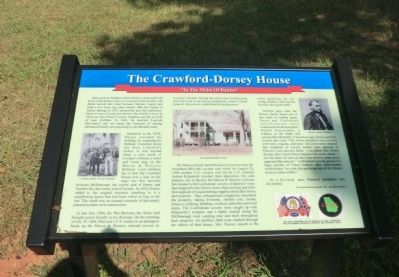Hampton in Clayton County, Georgia — The American South (South Atlantic)
The Crawford-Dorsey House
"In The Midst Of Battles"
Sometime in the 1850s, Dorsey extended his holdings by acquiring the William Crawford home site from Crawford’s widow. It was located about a mile north of Lovejoy’s Station, a water and wood stop on the Macon & Western Railroad. Local tradition has it that the Crawford House was a stop on the stage line that operated between McDonough, the county seat of Henry, and Fayetteville, the county seat of Fayette. In 1858, Dorsey added to the original structure attaching to it a neighboring house that had been rolled on logs to the site. The result was an unusual example of upcountry, plantation plain-style construction.
In late July 1864, the War Between the States had brought action literally to his doorstep. On the morning of July 29, 1864, McCook’s U.S. raiders in an attempt to break up the Macon & Western railroad moved on Lovejoy’s Station. During the raid, Union soldiers paid their first visit to the Dorsey plantation, where Colonel James R. Brownlow, established his headquarters.
The Dorsey family had little time to recover from the Stoneman-McCook cavalry raid when on August 20, 1864 another U.S. cavalry raid led by U.S. General Judson Kilpatrick reached their plantation. His sole purpose was to destroy the Macon & Western railroad, but clashed with Confederate cavalry. Kilpatrick’s men had stopped by the Dorsey home that morning and did a thorough job of requisitioning supplies from their home and property. They pillaged and completely ransacked the property, taking livestock, shelled corn, bacon, tobacco, clothing, bedding, crockery, and other personal items. The Confederate cavalry soon caught up with Kilpatrick’s troopers and a battle ensued along the McDonough road, sending shot and shell throughout their property. An artillery shell even crashed through the rafters of their house. Mrs. Dorsey stayed in the house protecting her two young children, who had the measles, during the battle.
Thirteen days later the Dorsey family home was in the midst of combat again. Union and Confederate fortifications were constructed on their property. Rachel Abercrombie, a witness to the battle that ensued after the battle of Jonesborough which lasted for several days said, “The whole plantation was covered with tents, wagon, and men.” An eyewitness claimed that hundreds of cavalry horses were grazing in Dorsey’s corn and pea fields. A neighbor who visited the day after Union forces departed the scene stated, “I saw the place all torn up, the crops entirely gone, and it appeared like a desert.” Left behind were the graves of a large number of Union soldiers. Mrs. Abercrombie testified that “we took the partitions out of the Dorsey house to make coffins.”
In a five-week span, Dorsey’s plantation was devastated.
The Atlanta Historical Journal, 1985-Vol. XXIX, Number 2
(captions)
Stephen Dorsey and his daughter
The Crawford-Dorsey House
General Judson Kilpatrick
Erected by Georgia Civil War Commission and the Georgia Historical Artifacts and Research Group.
Topics. This historical marker is listed in this topic list: War, US Civil. A significant historical month for this entry is July 1864.
Location. 33° 27.15′ N, 84° 18.732′ W. Marker is in Hampton, Georgia, in Clayton County. Marker is on McDonough Road, 0.1 miles west of Freeman Road, on the right when traveling west. Touch for map. Marker is at or near this postal address: 2471 McDonough Road, Hampton GA 30228, United States of America. Touch for directions.
Other nearby markers. At least 8 other markers are within 2 miles of this marker, measured as the crow flies. Cavalry Action at Lovejoy's Station (approx. ¾ mile away); The "Right Flank" on the McDonough Road (approx. 1.3 miles away); "The Old Bronze Gentleman of Lovejoy's Station" (approx. 1.3 miles away); Kilpatrick's Raid (approx. 1.3 miles away); Kilpatrick's Raid at the Nash Farm (approx. 1.3 miles away); Locomotive Bell from the Nancy Hanks (approx. 1.3 miles away); Constantine Memorial (approx. 1½ miles away); Georgia Militia at Lovejoy's Station (approx. 1.6 miles away). Touch for a list and map of all markers in Hampton.
Credits. This page was last revised on June 16, 2016. It was originally submitted on November 10, 2013, by Don Morfe of Baltimore, Maryland. This page has been viewed 1,181 times since then and 70 times this year. Photos: 1, 2. submitted on November 10, 2013, by Don Morfe of Baltimore, Maryland. • Bernard Fisher was the editor who published this page.

